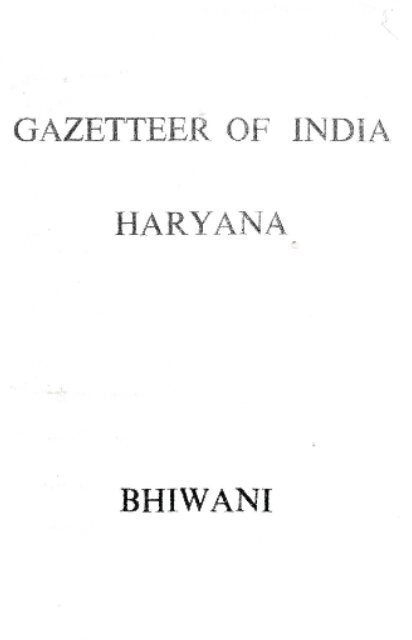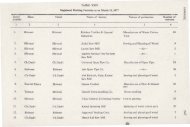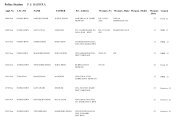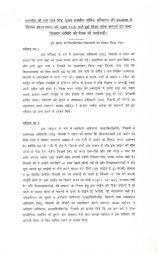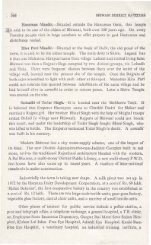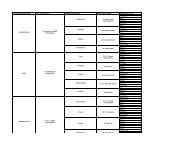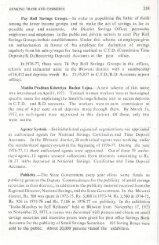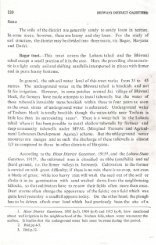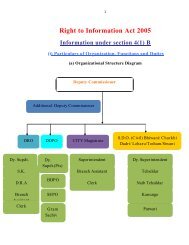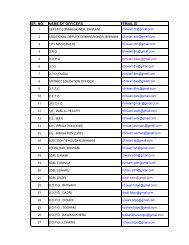chapter-i - revenue and disaster management department, haryana
chapter-i - revenue and disaster management department, haryana
chapter-i - revenue and disaster management department, haryana
Create successful ePaper yourself
Turn your PDF publications into a flip-book with our unique Google optimized e-Paper software.
GAZETTEER OF INDIA<br />
HARYANA<br />
BHIWANI
I-IAR' A DISTRICT GAZETTEERS<br />
.BHIWANI<br />
HARYANA GAZETIEERS ORGANISATION<br />
REVENUE DEPARTMENT<br />
CHANDIGARH (India)<br />
1912<br />
SUNIL AHUJA. lAS,<br />
State Editor (Gazetteers)<br />
"B.RAJ BAJN<br />
Editor
Tile 'outroll 'f, Printing a.nd Stationery,<br />
HaryaOI. Ch<strong>and</strong>igarh (India)<br />
Printed by :<br />
Controller of Printing an:! Stt.tionery.<br />
G():vernment of Haryana•.ChanJigarh .
Thi is thefirstgazetteer of the Bhiwani district which<br />
was created in December 1972.Thegazetteer contains useful<br />
information on important aspects of district life. The<br />
development in this arid di trict after the formation of<br />
Haryana has been phenomenal, plfticularly with the<br />
introduction of a network of canals through lift irrigation<br />
schemes. Introduction of irrigation in the centuries old<br />
desert tract is fast changing the lives of ~the people. The<br />
<strong>chapter</strong>s in this compendium have been so devised as to<br />
make the gazetteer useful to those engaged in administration,<br />
welfare programmes <strong>and</strong> research. The work, it is hop~d,<br />
will also be ofinterest to the general reader.<br />
Compliments are due to the Gazetteers Unit ~forhaving<br />
prepared such a voluminous work in a short period. I am<br />
thankful to Shri E.N. Mangat Rai <strong>and</strong> Dr. K.C. Khanna who<br />
revised the draft of the gazetteer.<br />
Ch<strong>and</strong>igarh,<br />
13thMay, 1982<br />
Financial Commissioner Revenue <strong>and</strong><br />
Secretary to Government, Haryana,<br />
Revenue Department.
. .. ... -.,-<br />
. .. .../ .• Jd.U<br />
Til) G.E)tte~r of Bh.1wam IS th) tha'd 1Q SUCCes.SlO f<br />
th." district glZ·~tteers so far brough~ out by th) H·:lry.:l.!1~<br />
G)v~rnmmt. This district wasform~d in D~cemb~r ~91i.})l<br />
integll.ting c)rtain t~rritories which p:~vloU3ty form)~: y.~r)f<br />
of two sep:uate districts. Bhiwani <strong>and</strong> Bawani .I(.~era)wjr~<br />
p:.ut of the Hisar district together with Loharu, ~ r~rm~J<br />
princely state. D.ldri, which at one tim~ belon!?ed:,;to 19.f<br />
erstwhile p::-incelystate of lind, came to Bhiwani fro~ !i~<br />
Mahendragarh district. : ,..) r ..tfJ.>I<br />
1 ~cessarily rdiance hid to b~ placed on old ga:zetteeffl,<br />
p.lrticularily of th~ Hisar district, for much of t1:pm:werial.<br />
Th~ Lohlru State G3.z~tteer, 1915 <strong>and</strong> th) Phulkfaq"~§t,,t8<br />
Gazetteer, 1904 w~re of imm;nse help. H:>wevtr~)tl?ast<br />
Indep;ndence developm)nts, espeCIally . aftee t h ~ creation . ~uf 0<br />
Haryana, had tobeincorpJrated from numeroU$ sources <strong>and</strong><br />
publications bJth of th; G:>vernm)nt <strong>and</strong> p::-ivatebodies. In<br />
the absence of relevant infonnltion many spot studies also<br />
had to be conducted.<br />
The introduction of canal irrigation in this seiifig~Nt~<br />
region is the singular IUOstsignificant transf~8:natl&IllIwHfch<br />
has taken place in recent years. Hence this gazetteer is not<br />
only a geographical <strong>and</strong> historical record but also tries to<br />
capture most of the major changes brought out by the<br />
development pro;;;ss. Its r~f~r~nc~ date, unless sp3cifically<br />
stated in thetext otherwise, is March 31, 1977.<br />
~.<br />
The writing <strong>and</strong> publication of'ta, nev\n'lgazetteeris atask<br />
involving mlny p~ople while it isn)tp)3si~.1~,to acknowledge<br />
eachof their contributbns individually sp~cial mention must<br />
be made of those who w~repdmarily resp:>nsible. My th:mks
are due to B. Raj Baja';, fomlerly Editor in the State<br />
Gazetteers Unit <strong>and</strong> his team ofResearch Officers S.P.Dheer,<br />
A.K. Jain _<strong>and</strong> Krishna Chakarvarti. S.P. Kainth, R.K.<br />
Malhotra <strong>and</strong> Tej Bhan, staff membels of. the [Gazetteers<br />
Unit also provided valuable assistance. lDr. K.C. Yadav,<br />
Kurukshetra University wrote the <strong>chapter</strong> OIl; History,<br />
Df.ICC. Khanna provided' expert comments. B.K. Kathpalia<br />
of the Haryana Develcpment Departmentp repared the maps.<br />
R.K. Sharda, formerly' District Public Relations Officer,<br />
Bhiwani was of great help during field visits. E.N. Mangat<br />
Rai, ICS (Retd.), was kind enough to go through the entire<br />
manuscript <strong>and</strong> make several improvements.<br />
Written on a pattern fprescribed by the Government<br />
ofIndia, it is hoped that this gazetteer would be of some<br />
use to both researchers <strong>and</strong> general ~readers alike.<br />
Ch<strong>and</strong>igarh,<br />
13th May, 1982<br />
State Editor (Gazetteers) <strong>and</strong><br />
[Joint Secretary to Government, Haryana.<br />
Revenue Department.
Origin of the nameofthe district<br />
Location, boundaries, area <strong>and</strong> population<br />
Location <strong>and</strong> boundaries-I,<br />
Area-I, Population-2<br />
History ofthe district as an<br />
administrative unit<br />
Topo~raphy<br />
Natural drainage, rivers <strong>and</strong> other surface<br />
water resources<br />
Mammals-I8, Birds-I9,<br />
Birds of economic importance-20,<br />
Reptiles-'-2I, Fishes-23<br />
Olimate<br />
Temperature-23, Humidity-24,<br />
RainfalI-24, Clouds-25.<br />
Winds-25, Special weather<br />
phenomena-25<br />
The ancient period<br />
The medieyal period<br />
The modern period<br />
1-2S<br />
27-40<br />
27<br />
30<br />
1<br />
1<br />
34
Religious groups-45, Superstitions-49,<br />
Festivals <strong>and</strong> fairs-50<br />
Socialgroups-52, Joint family<br />
system-59, Iuheritance-60,<br />
Marriage customs-62, Other rituals<br />
a!ldcustoms-68, Position of women-69<br />
Villages-7l, Dwellings,<br />
furniture <strong>and</strong> utensils-n,<br />
Dress <strong>and</strong> ornaments-74,<br />
Food-76<br />
Folk culture-77, Games <strong>and</strong><br />
recreation-80<br />
Refugee camps-82, Rural rehabilitation-83, Urban<br />
rehabilitation-84, Smallurban <strong>and</strong> house-building<br />
loans-85, Payment of compensation-86, Impact<br />
of displaced persons on local population-8?<br />
Irrigation<br />
Canalirrigation in the district prior to the formation<br />
of Haryana-93, Progress after theformation of HarylUla<br />
State-96, Newcanal irrigation schemes-98, Well<br />
irrigation-108, Tank irrigation-Il2, Minor irrigation<br />
(ground water exploration <strong>and</strong> development)-l12,<br />
Lining of kachcha watercourses-lIS, Cloud-seeding<br />
experimental operations for inducing artificial<br />
rainfall-117<br />
41-87<br />
41<br />
44<br />
89-173<br />
89
Agriculture<br />
Set-up of the agriculture <strong>department</strong>-lI8, Soils-120,<br />
Crops-125, Fodder crops-128, Horticulture-l30,<br />
Agricultural implements-131, Mechanised farming-l33<br />
Seed-I36, Manures<strong>and</strong> chemical fertiIizers-137,<br />
Agricultural pests <strong>and</strong> diseases-l39, Marginal Farmers<br />
<strong>and</strong> Agricultural Labourers Development Agency (MFAL),<br />
Bhiwani-140, Agricultural cooperatives-146<br />
Animal Husb<strong>and</strong>ry<br />
Cattle <strong>and</strong> buffaloes-150, Intensive Cattle Development Project,<br />
Bhiwani-151, Dairy farming-152, Sheep breeding-153,<br />
Piggery-,153, Camels-153, Horses <strong>and</strong> ponies- 153,<br />
Donkeys-.153, Animal diseases <strong>and</strong> veterinary hospitals-153,<br />
Slaughter houses-15ot, Poultry development-155, Problem of<br />
strllYanimals-155, Gaushala development-155<br />
Forestry<br />
Natural calamities (Famine <strong>and</strong> drought)<br />
Common facility centres<br />
Marke"ting assistance<br />
Industrial areas<br />
Commercial banks<br />
Rural industries project<br />
Industrial training<br />
Source of power<br />
Industries <strong>and</strong> manufacturell<br />
Large <strong>and</strong> medium-scale industries-194. Small-scale<br />
industries-204, Cottage industries-204<br />
Regiltered factories<br />
Industrial labour<br />
Cooperative movement<br />
155<br />
157<br />
165<br />
175-208<br />
175<br />
182<br />
183<br />
187<br />
188<br />
189<br />
189<br />
190'<br />
191<br />
192<br />
193<br />
205<br />
205<br />
206
Money-lenders <strong>and</strong> agricultural indebtedness<br />
Cooperative credit<br />
Central cooperative bank<br />
Primary l<strong>and</strong> deTelopmcnt banks<br />
Joint-stock banks<br />
Regional Rural Bank, Bhiwani<br />
Insurance<br />
Small savings<br />
School savings bank (Sanchayika) scheme-218, Pay roll<br />
savingsgroups-219, Mahila pradhan kshetriya bachat yojna-219,<br />
Agency system_219, Publicity-219<br />
Currency <strong>and</strong> coinage<br />
Trade <strong>and</strong> commerce<br />
Regulated markets<br />
Cattle fairs<br />
Stat~ trading<br />
Weights <strong>and</strong> measures<br />
Storage <strong>and</strong> warehousing<br />
CHAPTER VII_COMMUNICATIONS<br />
Roads<br />
National highway-238, State [highways-238,<br />
Other roads- 239,Road beautification programme-239,<br />
Canal inspection roads-240<br />
Vehicles <strong>and</strong> conveyances<br />
Passanger transport-240, Goods transport byroad-245,<br />
Railways-246, Transport by air-248<br />
Facilities for travellers<br />
Post offices<br />
208<br />
... 209-233<br />
209<br />
211<br />
213<br />
214<br />
214<br />
216<br />
217<br />
217<br />
220<br />
220<br />
222<br />
226<br />
227<br />
229<br />
232<br />
232<br />
•.• 235-255<br />
235<br />
248<br />
249
Telegraphs<br />
Telephones<br />
CHAPTER VIII-MISCELLANEOUS. OCCUPATIONS<br />
Educational personnel<br />
Engineering services<br />
Transport<br />
Personal services<br />
Barbers-275. Washermen-275. Tailors-276<br />
Livelihood pattern<br />
Employment situation<br />
Employment exchanges-286<br />
Wages<br />
Community development<br />
DistriGt authorities<br />
Deputy Commissioner-307. Sub-Divisional Officer-309.<br />
Tahsildar (Mahal)/Naib TahsiIdar (Mahal)-309<br />
General arrangement fordisposal of business<br />
General Assistant-31l. Additional General Assistant to<br />
Deputy Commissioner-312<br />
Other State <strong>and</strong> Central governmen~ officers<br />
State government officers-313, Central government officers<br />
(excluding military officers)-316<br />
253<br />
254<br />
... 257-281<br />
283-304<br />
283<br />
257<br />
259<br />
271<br />
272<br />
274<br />
275<br />
278<br />
278<br />
288<br />
298<br />
301<br />
... 305-318<br />
305<br />
307<br />
312<br />
313
Development organization<br />
Police<br />
Judiciary<br />
District Attorney<br />
Oath Commissioner<br />
CHAPTER XI-REVENUE ADMINISTRA nON<br />
History ofthe <strong>revenue</strong> administration<br />
Specialassessment onl<strong>and</strong> put tonon-agricultural use-328,<br />
The Punjab L<strong>and</strong> Revenue (Surcharge) Act, 1954-329,<br />
Adhoc SpecialAssessment under Punjab L<strong>and</strong> Revenue Act,<br />
No.6 of 1956-329, The Punjab L<strong>and</strong> Revenue (Special<br />
Charges) Act, 1958-329, Punjab Revenue Act XIX<br />
of 1958-329<br />
Other enactments<br />
Haryana L<strong>and</strong>-Holdings Tax Act, 1973-332<br />
L<strong>and</strong> <strong>revenue</strong><strong>and</strong> special cesses<br />
L<strong>and</strong> <strong>revenue</strong>/l<strong>and</strong>-holding tax-34/, Specialcesses (Village<br />
officers' cess-342, Local rate-342, Water rates-343,<br />
Betterment charges--343)<br />
L<strong>and</strong> reforms<br />
Consolidation ofholdings<br />
Other sources of <strong>revenue</strong>, State <strong>and</strong> Central<br />
State sources of<strong>revenue</strong>-359, Central sources of <strong>revenue</strong>-372<br />
CHAPTER XII-LAW AND ORDER AND JUSTICE<br />
Incidence of crime<br />
Police<br />
Jails<br />
Justice<br />
Public Works Department<br />
Public Health Engineering-407, Buildings <strong>and</strong> Roads-408,<br />
Irrigation-41O<br />
316<br />
317<br />
317<br />
317<br />
318<br />
318<br />
318<br />
318<br />
319-374<br />
319<br />
336<br />
338<br />
341<br />
343<br />
357<br />
359<br />
375-406<br />
375<br />
387<br />
396<br />
399<br />
407-428<br />
407
Haryana State Electrtcity Board<br />
Coopec:tive Department<br />
Depntment of Welfare of Scheduled Castes <strong>and</strong><br />
Backward Classes<br />
Finance Deparment<br />
Public Relations Department<br />
Fire Fighting Department<br />
Food <strong>and</strong> Supplies Department<br />
Planning Department<br />
National Savings Organization<br />
Departments of Town <strong>and</strong> Country Planning, Haryana<br />
Urban Development Authority <strong>and</strong> Colonization<br />
Krishi Gyan Kendra, Bhiwani (Haryana Agricultural<br />
University)<br />
Urb:lll local government<br />
Historical background-429. Municipalities (Bhiwani-429,<br />
Cbarkhi Dadri-432), Notifiod area committees (Loharu-435.<br />
TOiiham- 436, Siwani-437. Bawani lChera-438)<br />
Rural local government-Panchayati Raj<br />
Panchayats-440, Panchayat Samitics-442. ZiJaParishad-444<br />
CHAPTER XV-EDUCATION AND CULTURE<br />
Historical background<br />
Education of women<br />
Education of Scheduled Castses <strong>and</strong> Backward Classes<br />
Literacy<br />
Educational set-up<br />
Medium of instruction<br />
Incentives<br />
Colleges(including technical <strong>and</strong>professional)<br />
Technical schools<br />
Oriental schools<strong>and</strong> colleges<br />
Adult literacy <strong>and</strong> socialeducation<br />
Educa.ion ofthephysically h<strong>and</strong>icapped<br />
416<br />
417<br />
420<br />
420<br />
421<br />
421<br />
422<br />
;423<br />
424<br />
427<br />
.. 429-444<br />
429<br />
445-463<br />
445<br />
448<br />
449<br />
450<br />
451<br />
452<br />
452<br />
453<br />
458<br />
460<br />
4tH<br />
461
National Cadet Corps<br />
Sports<br />
Libraries<br />
Education infine arts<br />
CHAPTER XVI-MEDICAL AND<br />
SERVICES<br />
Medical <strong>and</strong>health services<br />
Diseasescommon to the district<br />
Vital statistics<br />
General st<strong>and</strong>ard ofhealth<br />
Preventive measures to promote public health<br />
Water-supply (rural)<br />
Water-supply (urban)<br />
Sewerage (urban <strong>and</strong> rural)<br />
CHAPTER XVII-OTHER SOCIAL SERVICES<br />
General<br />
Labour welfare<br />
Labour legislation-512, Industrial relations-513, Works committees-513.<br />
Strikes-513, Trade unions-513, Subsidized Industrial Housing<br />
Scheme-514, Government Labour Welfare Centre, Bhiwani-515,<br />
Employees' Provident Funds Scheme-515, Family Pension-cum-<br />
LifeAssurance Scheme, 1971-516 Deposit-Linked Insurance Scheme,<br />
1976-517, Employees' State Insurance Scheme-517<br />
Social welfare<br />
Old agepension-518<br />
Advancement ofbackward classes<br />
Haryana Harijan Kalyan Nigam Limited<br />
Prohibition<br />
Charitable organi~tions<br />
CHAPTER XVIII-PUBLIC LIFE AND VOLUNTARY<br />
SOCIAL SERVICE ORGANIZATIONS<br />
Representation of the district in the Union <strong>and</strong><br />
State Legislatures<br />
Lok Sabha-House ofPeople (First General Elections,<br />
1952-537, Second General Election~, 1957- 537,<br />
Third General Elections, 1962-538, Fourth General<br />
Elections, 1967-539, Fifth Gneral Election~, 1971-540,<br />
Sixth Gegeral ElactioRs, 1977-541), R,ajra Sabha (CoWlcil<br />
461<br />
462<br />
463<br />
463<br />
465-5O~<br />
467<br />
480<br />
486<br />
493<br />
494<br />
503<br />
506<br />
509<br />
511-535<br />
511<br />
511<br />
51~<br />
524<br />
525<br />
528
ofStates)-542, Vidhan Sablla-Legisll\tive Assembly (First<br />
General Elections, 1952-542, Second GenllJal Blectipnl,<br />
1957_543, Third Genera1 Elections, 1.962---643,FouAb<br />
General Elections. 1967-544,Mid-Ten;.~ EleetiOllS.I96I-545,<br />
Fifth General Electiooi, 19'n-S45.Sixth Goneta~Elections,<br />
1977-546 fn)<br />
Political parties <strong>and</strong> organizations<br />
Newspapers <strong>and</strong> periodicals<br />
Voluntary S9cia1service organizations<br />
CHAPTER XIX-PLACES OF INTEREST<br />
Bawani Khera-563, Bhiwani-564, Charkhi Dadri~567,<br />
l'aliana_569, Loharu-569, Mitathal-571, Siwaai-572,<br />
Tosham-573<br />
APPENDIX<br />
Contents ofTables-577, Tables I to XLYlII-580 to 701<br />
-=BIBLIOGRAPHY<br />
GLOSSARY<br />
INDEX<br />
546<br />
S~<br />
551<br />
563-575<br />
703-706 ;<br />
707-710<br />
711-727
(x)<br />
ILLUSTRATIONS<br />
Plate 1- Stone Implements: ring stone, hammer stone, etc., <strong>and</strong><br />
Plate 2- Copper Objects : riugs, celt, parsu; found in excavations<br />
at Mitathal-:- indicative of habitation at the site during<br />
Pre-Harappan to Late-Harappan times<br />
Rock inscription of 4th-5th centuary A.D., Tosham Hill<br />
Rural mela at village Nakta (tahsil Bhiwani)<br />
Beginnings of the gigantic effort to bring water to the thirsty<br />
arid l<strong>and</strong>s of theBhiwanidistrict<br />
Water flowsin one of the newly constructed channels to slake<br />
the thirst of'the arid l<strong>and</strong>s in the Bhiwani district<br />
Water being lifted through a pump house - a special feature<br />
ofthe Lift Irrigation System<br />
Bnergisationoftubewells<br />
MilkPlant, Bhiwani - a symbol ofwhite revolution<br />
Vaish College, Bhiwani<br />
Government College, Bhiwani<br />
Bringing of drinking water fromfar away places - an essential<br />
part ofliving pattern that existedprior tothe establishment of<br />
Bapora Water Works inthe seventies of thepresent century<br />
A panoramic view of Bapora Water Works - biggest rural<br />
\Vater-supply project<br />
Drinking water goesto villagesthrough taps<br />
Old pakka tanks with covered storage wells(kunds) forcoIlecting<br />
rain water for drinking (village Pokharwas) - now athing of<br />
the past<br />
Bhiwani Water Works - anaerial view<br />
Gauri Shankar M<strong>and</strong>ir, Bhiwani<br />
Dorothy Villa atCharkhi Dadri built by the Maharaja of<br />
erstwhile princely State ofJind - now PWD rest house<br />
Newly built 19-suitePWD Rest House, Bhiwani<br />
Shyamesar Tank, Charkhi nadri<br />
Tosham Hill- resembling asleeping camel<br />
MAPS (General, IrrigatioD)<br />
729<br />
730<br />
731<br />
734<br />
735<br />
736<br />
737<br />
738<br />
740<br />
741<br />
742<br />
743<br />
744<br />
745<br />
.. 745<br />
.. 746<br />
,. 746
Bhiwani, one of the eleven districts! of Haryana State, came into<br />
existence on December 22, 1972, <strong>and</strong> wasformally inaugurated on JailUary 14,<br />
1973. It is mmed after the headquarters. town of Bhiwani, believed to be a<br />
corruption of the word Bhani. From Bhani, itchanged to Bhiani <strong>and</strong> then<br />
Bhiwani. Tradition hasitthat oneNeem,aJatu Rajput, who belonged tovillage<br />
B:twani 2 , then inHansi tahsil of the Hisar (Hissar) district, came to settle at<br />
Kaunt, avillage near the present town of Bhiwani. This was resented by the<br />
local Jat inhabitants, <strong>and</strong> they plotted his murder. Neemwas warned by a Jat<br />
woman, named Bahni, <strong>and</strong> thus forewarned, had hisrevengeonthe localJats.<br />
He killed m~st of them at a banquet, the site ofwhich was mined with gunpowder.<br />
He m'lrried B:thni <strong>and</strong> founded a village named after her. At<br />
the beginning of the nineteenth century, Bhiwani was an insignificant village<br />
inthe Dadri pargana, under the control ofthe Nawab ofJhajjar. It is,however,<br />
referred to asatown whenthe British occupied it in 1810. 3 It gained<br />
importance during British rule when in 1817, it was selected for the siteof a<br />
m<strong>and</strong>i or free market, <strong>and</strong> Charkhi Dadri, still under the Nawabs, lost its<br />
importance as a seat of commerce.<br />
Location <strong>and</strong>boundaries.- The district ofBhiwani liesinbetweenlatitude<br />
2&019' <strong>and</strong> 290 OS' <strong>and</strong> longitude 750 28' to 760 28'. It isbounded in the<br />
north by the Hisar (Hissar) district, inthe east bythe Rohtak district, inthe<br />
south by the M'lhendragarh district of Haryana <strong>and</strong> theJhunjhunu district<br />
of Rajasthan <strong>and</strong> in the west by the Churu district <strong>and</strong> a part of the<br />
Jb:unjhunu district of Rajasthan.'<br />
Area.-With an area of 5,090square kilometres, Bhiwani isthe second<br />
1. The twelfth district of Faridabad hasbeen created on August 15. 1979.<br />
2. Arnin Ch<strong>and</strong>. Tawarikh -i-Zila Hisar. 1866. p.lS. Bawani is apparantely Bawani<br />
Mera. now the headquarters ofatahsil ofthe same name inthedistrict.<br />
3. Hisar District Gazetteer. 1892,pAl.<br />
4. S()ur~e: Survey OfIndia, North Westem Circle, Ch<strong>and</strong>il?arh.
largest district inthe State following Hisar (Hissar). It comprises four tahsils<br />
covering the areas shown below l :<br />
1,470.33<br />
.1,032.86.<br />
r,42L25<br />
1,165.56<br />
5,090.00<br />
4.51<br />
·2,59<br />
is.76<br />
1,458.67<br />
1,032.86<br />
1,416.74<br />
1,162.97<br />
5,071.24<br />
Population.~The district assuchwasnot inexistence atthe last Census<br />
of 1971 <strong>and</strong> separate population data have'not been published. However,<br />
the p::>pulation, computed on the basis of the 1971 Census, was 7,61,953<br />
persons. 2 In population, it is the eighth among eleven districts of the State<br />
following Gurgaon, Hisar (Hissar), Rohtak, Ambala, K.:;strnal,Kurukshetra<br />
<strong>and</strong> Jind <strong>and</strong> st<strong>and</strong>s ahead of Mahendragarh, Sonipat <strong>and</strong> Sirsa.<br />
The first record of the administrative division now compnsmg the<br />
Bhiwani district, is found in Ain-i-Akbari. Akbar divided his kingdom into<br />
subahs, sirkars <strong>and</strong> mahals or parganas. Thewhole of what isnow the Bhiwani<br />
district wasmostly in sirkar of Hisar Firuza (principal mahals being Tosham,<br />
Seoran <strong>and</strong> Siwani)3<strong>and</strong> sirkar ofDelhi (princip;il mahal beingDadri Taha)4 of<br />
sublh Delhi. With thedecay ofthe Mughal Empire this area remained disturbed<br />
in consequence of fighting between the neighbouring chiefs till 1803,when<br />
the greaterplrtofitcam~under British rulebythe TreatyofSurjiArjungaon.<br />
Thereafter conditions sealed down. The present district has been formed by<br />
1. Source: Deputy Commissioner, Bhiwat,i.<br />
2. Statistical Abstract ofHaryana, 1975-76,p.3. (Issued bytheEconomic <strong>and</strong> Statistical<br />
Organization, Planning Department, Haryana.)<br />
3. Abul Fazl, Ain-i-Akbari, Volume II (Englishtransiation by H. S.Jarrett, comc;ted<br />
!In~further annotated bySir Jadu"nath Sarkar);1949,pp. 298-~OQ.<br />
4. Ibid, PP.791-93•.
m~rgingthreesepirate units, viZ.(i):Bhl~a~r~rid l3awaniKhera, whichformeda<br />
p:trtoftheRisar (Hissar)district ;'(ii) Dadri, whichwas formerlya part<br />
ofa princelyState<strong>and</strong>-laterofthe Mahendragarh district; <strong>and</strong> (iii)Loharu,<br />
which was a princely' State <strong>and</strong> later merged with the Hisar (Hissar)<br />
district after Independence. These three tracts have different administrative<br />
histories.<br />
The first tract consisting ofthe. twotahsils of Bhiwani <strong>and</strong> Bawani<br />
Khera, wasa part ofthe territory knownasHaryana immediately prior tothe<br />
Britishconquestin1803 <strong>and</strong>wasnominaJIysubjecttothe Marathas, whoruled<br />
itinthe name of Mughal Emperor at Delhi. Siwani<strong>and</strong> Bahlwere 2<br />
of the 19districts into which Haryana had beendivided at that time. l In<br />
'1810,thedateoftheactual establishment of.the Britishauthority inthis part,<br />
the wholeofthe Delhi territory ceded 1;'ythe Marathas wassubjectto the<br />
ResidentofD~lhi, <strong>and</strong>wasdividedintotwodistricts: Delhi,already underthe<br />
Resident, <strong>and</strong> the outlying districts including' Hansi, Hisar (Hissar), Sirsa,<br />
Rohtak, Panipat <strong>and</strong> Rewari, under the' immediate charge ofan Assistant to<br />
the Resident. In 1819,theDelhiterritory wasdividedintothreedistricts: the<br />
central district whichincluded Delhi, the southern including Rewari, <strong>and</strong> the<br />
north-western including Panipat, Hansi, Hisar (Hissar), Sirsa <strong>and</strong> Rohtak.<br />
In 1820,the latter·(north-western) was again sub-divided into a northern<br />
<strong>and</strong>a w
Jaipur authority <strong>and</strong> t'orni~danindep~ndent State. TheRaja of Khetri, a dependencyofJaipur,<br />
attempted tosubdue-thembutwasslaininbattleatLoharu.<br />
The Statewas,however,re-annexedto Jaipur foratime, butitsoon regained<br />
its independence. Subsequently it acknowledged British suzerai.nty. The<br />
Britishrulersgavethetaluk ofLoharu (73&squarekilometres)in.rewardtothe<br />
Maharaja of Alwar, whohad loyallyaided them during the 1&03campaign<br />
against the Marathas. The sanad given by General Lord Lake to Raja<br />
SiwaeeBakhtawar SinghofAlwaronthis occasion istranslated asfollows l :-<br />
"To allMootsaddies, present <strong>and</strong>future"as wdl asto Amils,Choudhrees,<br />
Kanoongoes, Zamindars <strong>and</strong> Cultivators ofParganas, Ismaeelpooro,<br />
<strong>and</strong> MJodawar withthe Talookasof Darbarpore, Rutaee, Nimrana, M<strong>and</strong>an,<br />
Ghelote, Beejwar, Suraie, Dadree, Loraroo, Boodwanah <strong>and</strong> Bhoodchalnahur,<br />
underthe Soobah of Shahjehanabad : Letit beknownthat betweenthe<br />
Honourable the East Indian CompanyofEngl<strong>and</strong> <strong>and</strong> Maharao Raja Sewaee<br />
B!lkhtawarSingh thefriendshipwhichexistedhasbeenstcengthened;therefore,<br />
witha viewofproving<strong>and</strong> makil\gthisfactpublictoeveryone, GeneralLord<br />
Lake directsthat the above-mentioneddistrict be madeoverto theMaharao<br />
Raja for his expenses,subject to the concurrence of the Most Noble the<br />
Governor-General, Lord Wellesley.<br />
"On thepermissiotlof tbe GovertlUr-General beiqg received,another<br />
Sanad willbe giveninplaceofthe p,resentone,which willberecalled.<br />
"Until another Sanad arrives, this one wtu remain inpossessioll of<br />
the Maharao Raja.<br />
"Parganas Ismaeelpore<strong>and</strong> Moodawar, withthe Talookas ofDarbarp:>re,Rutaee,<br />
Nimrana, M<strong>and</strong>an, Beejwar<strong>and</strong> Ghelote <strong>and</strong> Suraie, Dadree<br />
<strong>and</strong> Laharoo, Boodwanah <strong>and</strong> BhQOdchalnahur,.<br />
"Dated 2&thNovember, A.D. 1803, corresponding with the 12thofthe<br />
Shaban, 121&.Hijreeor AghunSood Pooranmassee, Sambat, 1&60.<br />
"(Signed)G. Lake."<br />
The Maharaja intam, with the assentofthe BritishGovernment, entrusted<br />
Loharu tohis vakeel,Ahman BakashKhan, whohad foughtgallantly<br />
onthe British side under the title Gf Nawab.= His d~cendants ruled this<br />
1. Powlett. P.W., Gazetteer01utwar,1878 (Lendon). p. 171.<br />
2. HisarDistrict<strong>and</strong>LoharuState Gazetteer (Lohar.uStat~. ~915,pp. 2.3; A/war<br />
District Gautteer, 1968, p.65.
State till it wasmerged, except 15 viliages, with the Hisar (Hissar) district<br />
under the Provinces <strong>and</strong> States (Absorption ofEnclaves) Order, 1950. 1<br />
According to the Phulkian States Gazetteer (Patiala, Jind <strong>and</strong>Nobha),<br />
1904,2 Charkhi Dadri town was formerelyinthe possession ofNawab Bahadur<br />
Jang, a relative ofthe Jhajjar Nawab. Inthe events of 1857, his estates<br />
were confiscated. Dadri area, covering nearly 600 square miles3 (1,554<br />
sqUlre kilometres) was first included inthe newly created district ofJhajjar,<br />
which was abolished shortly afterwards in 1860 when large parts ofit were<br />
assigned to the Phulkian Chiefs, asa reward for their servicesto the British<br />
Government.' Dadri was conferred on Raja Sarup Singh of Jind.5 Till<br />
1904,Dadri wasatahsil ofthe Jind district (Nizamat). In that year, Dadri<br />
tahsil wasmade into a separate district. 6 After Independence (1947),<strong>and</strong><br />
the subsequent formation of PEPSU (Patiala <strong>and</strong> East Punjab States Union)<br />
onMay 5,1948,the Dadri area ofthe Jind State wasincluded intheMahendragarh<br />
district. Under the States Re-organisation Act, 1956, PEPSU was<br />
merged with Punjab on November 1,1956, <strong>and</strong> consequently theMahendragarh<br />
district, of which Dadri was a part, became one of the then 19districts<br />
of Punjab. The four villages of the Dadri tahsil, viz. Umrawat, Ralluwas,<br />
Dharana <strong>and</strong> Rajgarh, with atotal area of 31.49 square kilometres were<br />
transferred to the Bhiwani tahsil of the Hisar (Hissar) district. The village<br />
~<br />
Umrawat was actually transferred on October, 6, 1969,while the other three<br />
villages had beentransferred on August 10,1962. 7<br />
This entire area wasincluded inthe newState of Haryana on November<br />
1, 1966. The above administrative arrangements continued till the<br />
neW district of Bhiwani comprising the Dadri, Loham, Bhiwani <strong>and</strong> Bawani<br />
Khera tahsils with headquarters at Bhiwani was constituted on December 22,<br />
1972, by varying the limits ofthe Mahendragarh <strong>and</strong> Risar districts so as<br />
to exclude th.e areas of the Dadri tahsil of the Mahendragarh district,<br />
<strong>and</strong> Loham, Bhiwani <strong>and</strong> Bawani Khera tahsils of the Hisar district.s<br />
L Census of India. 1961, District Census H<strong>and</strong>book. Hisar District, 1966.p. 11.<br />
2. Ibid. p.333.<br />
3. Ibid, p.216.<br />
4. Rohtak District Gazetteer, 1970, p. 3.<br />
5. PhulkiQJlStates -Gazetteer (Patiala, Jind <strong>and</strong> NaMa), 1904·,p. 333.<br />
'6. Phulkian States Gazetteer. Statistical Tables (find State), 1913, p. 3.<br />
7. Census of India. 1971, District Census H<strong>and</strong>book, Mahendragarh District. 1973, p.5.<br />
8. Vide Haryana Government. Revenue Department Notification No. 6050-E(IV)-72/<br />
451123, dated December 22, 1972.
The following table shows the number of villages -ineach tahsilon the eve of<br />
the formation of the Bhiwani district <strong>and</strong> thereafter :-<br />
Number of<br />
villages on<br />
the eve of<br />
December<br />
22, 1972<br />
Nil<br />
(tahsil not<br />
in existence)<br />
Number of Remarks<br />
villages on<br />
December<br />
22, 1972<br />
114 (i) 37 villages were transferred<br />
to the Loharu<br />
tahsil.<br />
(ii) 6 villages .were transferred<br />
to the Bawani<br />
KJ-..era tahsil.<br />
(iii) 9 villages were added<br />
from the Dadri tahsil.<br />
(i) 6 villages were added<br />
from the Bhiwani tahsil.<br />
(ii) 32 villa:ges were added<br />
from the Hansi tahsil of<br />
the Hisar district.<br />
(iii) 17 villages \yere added<br />
from the Hisiif tahsil of<br />
the fIisar district.<br />
(i).9 villages were trans.,.<br />
ferred to the Bhiwani<br />
tahsil.<br />
(ii) 20 ,villages were .added<br />
from the Mahep.dragarh<br />
tahsil of the Mahendragarh<br />
dj..strict. .<br />
(i) 2 villages were added<br />
from the Mahendragarh<br />
tahsil of the Mahendragarh<br />
district:' ,<br />
(ii) 37 villages were added<br />
. .. frOJ:.n.t4e Bhiwani t~hsiL
OnApri123, 1974, 12villages (Jarwa, Basri, Sohari, Nanwan, Nanga1<br />
- . -<br />
Mala, Satnali, Birsingwas, -SuretiJhakaf, Sureti Pilania, Sureti Maveryana,<br />
phana <strong>and</strong> Bas) were transferred from the Dadri tahsil tothe Loharu tahsil.<br />
.5villages (Nimriwali, Pahladgarh, N<strong>and</strong>gaon, Rupgarh <strong>and</strong> Madh Mathvi)<br />
.wereincluded in the Bhiwani tahsil from the Dadri tahsil. One village, Indiwali,<br />
was also included in the Bhiwani tahsil from the Loharu tahsiJ.1 On<br />
the Slme day, 3 villages ofthe Dadri tahsil (Bhurjat, Kharkhara <strong>and</strong> Adilpur)<br />
were incorpJrated in the Mahendragarh tahsil of the Mahendragarh<br />
district; 5villages ofthe M'ihendragarh tahsil (Barda, Dalanwas, Gadarwas,<br />
Madogarh <strong>and</strong> Degrota) were transferred to the Loharu tahsil <strong>and</strong> 1village,<br />
Nasuha, of the Mlhendragarh tahsil was transferred to the Dadri tahsiI.2<br />
OilJune 11,1974,5 villagesofthe Loharu tahsil (Isharwal, Dewawas, Rodhan,<br />
Salhawahi <strong>and</strong> Hasan) were included inthe Bhiwani tahsil <strong>and</strong> 3 villages<br />
(Kakral, Sewani<strong>and</strong> Naloi) inthe Bawani Khera tahsil. 3 Thus the Bhiwani<br />
district, on March 31, 1977, comprised 474 villages, divided between tahsil<br />
Bhiwani: 125,tahsil Bawani Khera :58,tahsil Dadri: 172<strong>and</strong> tahsil Loharu :<br />
119.<br />
SUB-DIVISIONS, TAHSILS AND THANAS<br />
The district has 4 tahsils :Bhiwani, Bawani Khera, Dadri <strong>and</strong> Loharu.<br />
Sub-divisions were created at Bhiwani, Dadri <strong>and</strong> Loharu on September 3,<br />
1954,September 4, 1968<strong>and</strong> November 10,1976 respectively. The Bawani<br />
Khera tahsil is under the Sub-Divisional Officer, Bhiwani.<br />
There are 9 thanas(police stations) <strong>and</strong> 8police posts. 4 Details may<br />
be seenin the Chapter on 'General Administration'.<br />
TOPOGRAPHY<br />
According to the Hisar District <strong>and</strong> Loharu State Gazetteer (Hisar<br />
District), 1915,the general aspect ofthe district, (which included much of the<br />
present B~iwanidistrict), m1ybedescribed asalevelplain orprairie, stretching<br />
from the north-west to the south east, <strong>and</strong> unbroken byany natural irregularity,<br />
except in the south-western corner where some of the detached peaks<br />
1. Vide Haryana Government, Revenue Department Notification No. 2278-RIV-74/<br />
11546,dated April 23, 1974.<br />
2. Vide Haryana Government, Revenue Department Notification No. 2278-RIV-74/<br />
11547,dated April 23,1974.<br />
, 3. Vide Haryana Government, Revenue Department Notification No. 3059-RIV-74/<br />
19359, dated June 11, 1974.<br />
4. The police post of Bahl having been up-graded as police station on April 1 1977,<br />
there arenow 10 police stations <strong>and</strong> 7policeposts. _- --,
of theAravalli range st<strong>and</strong> out against the horizon. The highest ofthese is<br />
the Tosham hill, 800 feet(244 metreS)high. As<strong>and</strong>y tract stretches down the<br />
western portion ofthe district tillthe Bhiwani area is entered, wherethe district<br />
presents the appearance ofaseaof s<strong>and</strong>y billows ofamore or less fluctuating<br />
nature. The whole of the Bhiwani tahsil, leaving out a smallportion<br />
inthe east whichwasapart oftheso-called Haryana tract, was known as<br />
Bagar. Here the prevailing characteristic is a light s<strong>and</strong>y soil <strong>and</strong> shifting<br />
s<strong>and</strong>-hills interspersed in places with firmer<strong>and</strong> inpart loamy bottoms. The<br />
s<strong>and</strong>-hills are known astibbas<strong>and</strong> the firmer valleysbetween as tals. 1<br />
As regards the Loham tahsil, "The aspect ofthe country isuniform<br />
throughout the State. It presents a prospect, dreary <strong>and</strong> d~solate, a treeless<br />
waste dotted with s<strong>and</strong>-hills, <strong>and</strong> sparsely covered with vegetation. No<br />
natural divisions can be said to exista,ndthe hill system.ificomprised intWQ<br />
hills which rise in rocky isolation inthe centre ofthe State."2<br />
As regards the Dadri area, according to the Phulkian States Gazetteer<br />
(Patiala,find <strong>and</strong> Nabha), 1904,3 itlayin Haryana tract <strong>and</strong> Badhara in the<br />
Bagar which was acontinuation ofthe Bagar ofthe Bhiwani tahsil, though<br />
water was50to 54 feet(15to 16.5metres) belowthesurface.<br />
As regards the river system inthe Dadri tahsil the Phulkian States<br />
Gazetteer(Patiala,find <strong>and</strong> Nabha), 1904, records that "Tahsil Dadri, which<br />
has no canal irrigation, iswatered bythe Dohan, a stream which rises inthe<br />
l<strong>and</strong>s of Ghoghu <strong>and</strong> Bhagaur, two villages of the Jaipur State, whence it<br />
flows past the Patiala town ofKanaud <strong>and</strong> thereafter irrigates the Jind villages<br />
ofPalari, Badhwana, Jawa, Jhojhu Kalan, Balali, Abidpura, M<strong>and</strong>ola, Kaliana<br />
<strong>and</strong> Dadri for some 15 or 16miles (24 or 26 kilometres), disappearing inthe<br />
dakar l<strong>and</strong> of kalyawas (Kaliawas) in Rohtak. When in flood in the rainy<br />
season, itis used tofertilize thel<strong>and</strong>s belowitslevelfor two orthree years, but<br />
itwas apt inyears ofheavy rainfall tocause damage both to houses <strong>and</strong> crops,<br />
<strong>and</strong> is now controlled by three dams, of which the first, raised in 1874, lies<br />
between the roads leading from Dadri to Kaliana <strong>and</strong> Jhajjar, whilethe second<br />
isbetween those leading to the Dadri railway station <strong>and</strong> the Johawala tank<br />
near the town, <strong>and</strong> the third, made in 1886, adjoins Dadri station, lyingbetweenthe<br />
road leading from the town to Rawaldhi <strong>and</strong> that leading from<br />
the town to the Station. The worst floods occurred in 1862 <strong>and</strong> 1885. In<br />
the latter year considerable damage was done in the town of Dadri both to<br />
1. Ibid,pp.2,4.<br />
2. Hisar District <strong>and</strong> Loham State Gazetteer (Loharu Stq.te), 19{5. p..1.<br />
~. lhili, p. 214.
priVateproperty 3_ndtothe State Khata.~orgrain stores, whichwere destroyed.<br />
The lossto the ~tate alone was estimated at a lakh of rUpees. The b<strong>and</strong>s,<br />
whichkept th~water ofthe Dohan from entering the town, alsoprevented the<br />
surface drainage ofthet0wn itself from findingan outlet, <strong>and</strong> thus injury tothe<br />
place resulted."l<br />
The waters ofDohan have,however,ceasedtoflowintothe Dadri tahsil.<br />
At least since 1947,no floods from tbis stream have afflictedthis tahsil. The<br />
stream gets a.bsorbed in the arid il.nd s<strong>and</strong>y tract of Mahenrlragarh district<br />
<strong>and</strong> completdy vanishes near villagesAkodah <strong>and</strong> Bassiwhich are situated on<br />
the Narna'll-Mlhendragarh-Dadri Road close to the north~rn border ofthe<br />
Mahendragarh district.<br />
The newly carved out district occupies a transitional position between<br />
the fairly flat <strong>and</strong> featureless Punjab-Haryana Plains onthe one h<strong>and</strong>,<br />
<strong>and</strong> the Rajasthan desert <strong>and</strong> the Aravalli hills on the other. Amajor portion<br />
of this transitional tract is a s<strong>and</strong>y, undulating plain dotted with<br />
s<strong>and</strong>-dunes of varying shapes <strong>and</strong> dimensions occurring in different directional<br />
dispositions. The monotony of the s<strong>and</strong>y plain is broken in parts<br />
by the hills which once were a part of the Aravalli mountain system,<br />
one of the oldest in the country. The north-eastern part of the district,<br />
by contrast, isa fairly flat plain. The highest point in" the district is 1,470<br />
feet(44&metres) above sealevelnear Kaliana inthe Dadri tahsil. The general<br />
topography of the district bears distinct imprint of the influence of both wind<br />
<strong>and</strong> water. In severalparts ithas thecharacteristics ofdesert topography <strong>and</strong><br />
arid l<strong>and</strong>scapes. This isalso confirmed inthe term 'Bagar' which isaclimatic<br />
term indicating arid conditions. Ofthe districts comprising the State of<br />
Haryana, Bhiwani comes next to Gurgaon <strong>and</strong> Mahendragarh in physiographic<br />
diversity.<br />
A closeexamination ofthe relief ofthearea reveals afourfold division<br />
of the district into physiographic units :<br />
(i) the north-eastern part, which isfairly flat;<br />
(ii) the central <strong>and</strong> north-western zone with a fair spread oflowhills<br />
of different dimensions, occurring in varying directions, <strong>and</strong><br />
interspersed by s<strong>and</strong>-dunes in parts;<br />
(iii) the s<strong>and</strong>y triangular zone enclosed by Bhiwani, LoharU <strong>and</strong><br />
Jhumpa; <strong>and</strong>
BHIw ANI DISTRICf GAZ~~~E~~<br />
(iv) the eastern 'lnd north--ea3terI)..part ofthe.I?adri tah~i1wlljcll,b_as<br />
~ .- .•.. _._~~. _._".~.#' .• ~,... ~.' ,." ..• ", f" ••.•.. r. \ ~r<br />
., ·a mixtu.reofplain ap_.dhilltopography,.th~~i11s bliadicin-~occurrehce.· -- ., , .. ,. '- -" .-<br />
(i) The North-eastern ZC?ne<br />
This zone includes n large part of the Bawani Khera ·tahsil <strong>and</strong> the<br />
north-eastern section oftheBhiwani·tahsil.' It is·generally fiat,with anortheast<br />
to south-west inclir.ation.. The southern <strong>and</strong> south-western limits oft1>.is<br />
top::>graphicunitare ID'irkedbythetermination ofdistributarie3 ofthe Western<br />
Yamum (Juffina) C-?,nalSy;tem, The predominance. ofhills arid s<strong>and</strong>-dunes<br />
westof this zone (i)versethe inclimtion ofthe l<strong>and</strong> cpar8.cteristic oLthe:canal<br />
irrigated area. The area north-east of the Bhiwani-Db Rmiyan (Dhamana)<br />
axis ispractically flat <strong>and</strong> presents a plain's l<strong>and</strong>s~~pe.<br />
---~.-.-<br />
Throughout this belt the altitude ranges between 695 <strong>and</strong> 741 feet<br />
(212 <strong>and</strong> 226 metres) above seaievel. However, there i-;a:stray occurrence of<br />
s<strong>and</strong>-dunes evenhere; suchasnear villagesBaliyali<strong>and</strong> Badesra intbe Bawani<br />
Kbera tahsil, <strong>and</strong> near villages Chang <strong>and</strong> Rewari inthe Bhiwani tahsil.<br />
(ij) The Central <strong>and</strong> North-western Zone<br />
Thiszoneispractically enclosed bythe linesjoining theplaces: Tosham-<br />
B'ljina-Rodha-Jhumpa-Gurera-Barwa-Dhamiyan (Dha.mana)- Tosham. The<br />
characteristic feature ofthe topography isthe relictype ofhills occqrring all<br />
oVerthe area. These hills arepHt ofthe old Aravalli mountain sY5
of·the adjoining Rajasthan desert. 'this 30neisci~stered with s<strong>and</strong>-dune sof<br />
varying shapes.<strong>and</strong> dimensions. In between the s<strong>and</strong>-dunes ar~ fairly level<br />
s<strong>and</strong>y surfaces which constitute the main agricultural l<strong>and</strong>. Of course, the<br />
general top0graphy ismarked byirregularities <strong>and</strong> undulations. Thedirection<br />
ofthe s<strong>and</strong>-dunes isinconsistent. The general altitude ofthis tract varies between<br />
750 <strong>and</strong> 870 feet (229<strong>and</strong> 265 metres). However, there isahillypoint<br />
called 'Pabari' which is 1,064 feet (324 metre.s). The s<strong>and</strong>-dunes, which are<br />
quite closely spaced, repnsent an extension ofthe lan.dscape across tbe State<br />
borde1fin Rajasthan.<br />
This tract includes the eastern part of the Dadri tahsil. It is a true<br />
transition betw~enthecanal irrigated, <strong>and</strong> fairly flat area ofthe Rohtak district<br />
inthe north-east <strong>and</strong> the irregular <strong>and</strong> s<strong>and</strong>y topography onthe southwest.<br />
The proportion of levelsurface is higher here than in the s<strong>and</strong>y tract.<br />
The s<strong>and</strong>-dunes <strong>and</strong> relic hills are only sporadic in occurrence. These relic<br />
hills orkOl'jes aresome 34innumber. The general surface isaround 700 feet<br />
(213 metres). The highest point near Kaliana, south-west of Cbarkhi Dadri<br />
<strong>and</strong> 1,470 fed (448metres) above sealevel,is on ahill.The other highpoint<br />
1,084 feet (330 metres) isanother hill near Mankawas. Afu ther hillis near<br />
Siswala with its highest point 1,332feet(406 metres). There aresimilar isolated<br />
hill tops tothe south.<br />
Although the basal foundation of the district is practicaJly uniform,<br />
thepresence ofs<strong>and</strong>-dunes, s<strong>and</strong>-hills <strong>and</strong> relicsoftheAravalli mountain system<br />
lends diversity to itstopography.<br />
The 'Rl.gar', closely dotted with s<strong>and</strong> features of varying shapes <strong>and</strong><br />
sizes,inthe southern <strong>and</strong> south-western parts of thedistrict isinmarked contrast<br />
to the fairly levell<strong>and</strong>scape ofthe Bawani Khera area inthe nortb-eas;;t.<br />
Thus the district provides atrue physiographic transition between the Punjab-<br />
Haryana plains in the northeast <strong>and</strong> the Rajasthan desert to the south-west.<br />
NATURAL DRAINAGE, RIVERS AND OTHER SURFACEWATER RESOURCES<br />
The Bhiwani district isone ofthe veryfewareas inthe wbole State of<br />
Haryana, which does'not bear the 'imprint ofany river or evena regular seaso"nalstream.<br />
The water seasonally flowingdown the slopes ofthe Aravalli<br />
rdics fn northern part of.the Mahendragarh district has carved out gullies,<br />
som~ofwhich extend into the snuthern parts ofthe Dadri tahsil. But these<br />
gullies disapp~ar within a few -kilometres after entering the district. During<br />
the monsoon water rushes into them from the adjoining hillocks, but issoon
absorbed in s<strong>and</strong> through percolation <strong>and</strong> evaporation. Thus the only limited<br />
signs of natural drainage in the district are of ephemeral hil<strong>and</strong> drainage.<br />
There are no other traces of eVenseasonal rivulets or streams elsewhere inthe<br />
district. Nevertheless, inthe central <strong>and</strong> north-western parts, where there is<br />
a fair scattering of the remains of the Aravalli system, water does collect in<br />
low-lying areas after the rains, forming ponds orwhat are locally called tals.<br />
These pondsjtals dry upduring summer. There is,however, hardly anyvillage<br />
where there isnopond. Theseponds are formed in naturally low-lyingareas,<br />
orlocations from wherethe earth has beenremoved for making mud bricks for<br />
house construction.<br />
In most parts ofthe district water-table is fairly deep, <strong>and</strong> the water<br />
brackish. Both these conditions render difficult well or tubewell irrigation.<br />
Theonly conspicuous water channels to be seen inthe district are those of<br />
canals, distributaries <strong>and</strong> minors dug <strong>and</strong> constructed recently.l Thus the<br />
general lack of natural drainage or water bodies symbolises the :lrid conditions<br />
dominant inthis district.<br />
A large part of the district iscovered by recent to subrecent deposits<br />
of alluvium <strong>and</strong> blown s<strong>and</strong>. The rock exposures are veryfew<strong>and</strong> these are<br />
generally inthe form ofa chain ofdiscontinuous hills.<br />
The general stratigraphic sequence ofvarious litho units encountered in<br />
the district isgiven below:<br />
Delhi Super Group<br />
Granite, amphibolite, quartz veins,<br />
pegmatite <strong>and</strong> porphyry<br />
Ajabgarh Formation Slates <strong>and</strong> phyllites with quartzite intercalations,<br />
quartzite, schists <strong>and</strong> gneisses<br />
Massive erruginous <strong>and</strong> calcareous<br />
quartzites, schistose quartZIte with<br />
thin b<strong>and</strong>s of carbonaceous phylite,<br />
quartz-sericite-muscovite schist, quartzbiotite<br />
schist.


